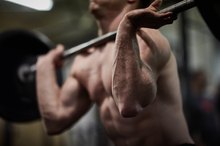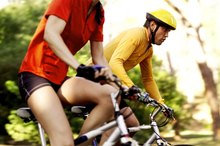Bicycling & Increased Testosterone Levels
In competitive endurance sports such as cycling, increased levels of testosterone could offer several performance benefits. Unfortunately, the specific details of proper bike training to raise testosterone levels remains uncertain. Most studies examining changes in testosterone levels have focused on resistance training rather than aerobic or endurance training. You can still make some safe assumptions that may help you improve your cycling performance.
Performance Benefits
Most importantly to cycling performance, the hormone testosterone promotes protein synthesis -- the rebuilding of tissues and development of muscle. In response to exercise, protein synthesis results in increased size and strength of muscle. As this occurs, more force can be applied to the pedals while riding, which generally translates into faster speeds.
How to Ride
Carbohydrates & Testosterone
Learn More
In his book, “Hormonal and Metabolic Adaptations to Exercise,” Henrik Galbo says that high-intensity aerobic exercise stimulates increased testosterone in the blood during and after exercise 1. In a study on resistance training by William Kraemer, testosterone levels were significantly increased as the workload increased and rest phases decreased. In application to cycling, putting in the miles at high intensity levels would increase testosterone levels during and after exercise and subsequently help improve your performance.
Too Much
While cycling at high intensities and volumes may increase testosterone levels, too much can be a bad thing. During a ride, the body mostly breaks down proteins through the release of other hormones, such as cortisol. After exercise, testosterone then helps the recovery process. In a study on elite swimmers in which training volumes were doubled in 10 days, J.P. Kirwan and associates reported significant rises in cortisol and steady declines in testosterone.
- While cycling at high intensities and volumes may increase testosterone levels, too much can be a bad thing.
Female Cyclists
The Effects of Testosterone Boosters on the Body
Learn More
Of the studies performed, few have been able to demonstrate significant increases in testosterone after exercise. Women have about 15 to 20 times less testosterone than men, so this would seem logical. Regardless of testosterone levels, women still show dramatic improvements in cycling performance with consistent, proper training.
Weight to Power Ratio
Most cyclists want more power -- which stems from larger, stronger muscles -- without adding too much body weight since carrying extra weight could slow you down. Although increased testosterone levels do occur in high-intensity endurance exercise, Kraemer suggests that muscle enlargement does not actually occur. Researchers Jack Wilmore and David Costill report that well-trained runners have decreased testosterone levels at rest 5.
Related Articles
References
- "Hormonal and Metabolic Adaptation to Exercise"; Henrik Galbo; 1983
- "Journal of Applied Physiology"; Compatibility of High Intensity Strength and Endurance Training on Hormonal and Skeletal Muscle Adaptations; William J. Kraemer; 1993
- "Medicine and Sports Science in Exercise"; J.P. Kirwan
- "Journal of Applied Physiology"; Hormonal and Growth Factor Responses to Heavy Resistance Exercise"; William J. Kraemer; 1990
- "Physiology of Sport and Exercise"; Jack H. Wilmore, David L. Costill; 2004
- Volek, J. S., Kraemer, W. J., Bush, J. A., Incledon, T., & Boetes, M. (1997). Testosterone and cortisol in relationship to dietary nutrients and resistance exercise. Journal of Applied Physiology, 82(1), 49-54.
- Wang, C., Catlin, D. H., Starcevic, B., Heber, D., Ambler, C., Berman, N., ... & Swerdloff, R. S. (2005). Low-fat high-fiber diet decreased serum and urine androgens in men. The Journal of Clinical Endocrinology & Metabolism, 90(6), 3550-3559.
- Heller, R. F., Wheeler, M. J., Micallef, J., Miller, N. E., & Lewis, B. (1983). Relationship of high density lipoprotein cholesterol with total and free testosterone and sex hormone binding globulin. Acta Endocrinologica, 104(2), 253-256.
- Blesso, C. N., Andersen, C. J., Barona, J., Volek, J. S., & Fernandez, M. L. (2013). Whole egg consumption improves lipoprotein profiles and insulin sensitivity to a greater extent than yolk-free egg substitute in individuals with metabolic syndrome. Metabolism, 62(3), 400-410.
- Steels, E., Rao, A., & Vitetta, L. (2011). Physiological Aspects of Male Libido Enhanced by Standardized Trigonella foenum-graecum Extract and Mineral Formulation. Phytotherapy Research, 25(9), 1294-1300.
- Prasad, A.S., et al. (1996). Zinc status and serum testosterone levels of healthy adults. Nutrition, 12, 344.
- Topo, E., Soricelli, A., DâAniello, A., Ronsini, S., & DâAniello, G. (2009). The role and molecular mechanism of D-aspartic acid in the release and synthesis of LH and testosterone in humans and rats. Reproductive Biology and Endocrinology, 7(120), 1482-1488.
- Wehr, E., Pilz, S., Boehm, B. O., Marz, W., & Obermayer?Pietsch, B. (2010). Association of vitamin D status with serum androgen levels in men. Clinical endocrinology, 73(2), 243-248.
- ZELIGS, M. A. (1998). Diet and estrogen status: the cruciferous connection. Journal of Medicinal Food, 1(2), 67-82.
- Shaner, A. A., Vingren, J. L., Hatfield, D. L., Budnar Jr, R. G., Duplanty, A. A., & Hill, D. W. (2014). The acute hormonal response to free weight and machine weight resistance exercise. The Journal of Strength & Conditioning Research, 28(4), 1032-1040.
- Kraemer, W. J., Marchitelli, L., Gordon, S. E., Harman, E., Dziados, J. E., Mello, R., ... & Fleck, S. J. (1990). Hormonal and growth factor responses to heavy resistance exercise protocols. Journal of Applied Physiology, 69(4), 1442-1450.
Writer Bio
Residing just outside Atlanta, Scott Flynn began writing in 2010. He currently works as a full-time college instructor and part-time multi-sport coach. He earned his master's degree in exercise science from the University of Georgia and is certified as a Clinical Exercise Specialist by the American College of Sports Medicine.








